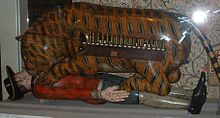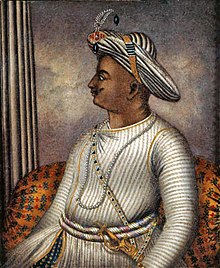Siege of Seringapatam (1799)
| date | April 5, 1799 to May 4, 1799 |
|---|---|
| place | Seringapatam , Indian subcontinent |
| output | British victory |
| consequences | Death of Tipu Sultan and Mysore loss of its independence |
| Parties to the conflict | |
|---|---|
| Commander | |
|
General George Harris |
|
| Troop strength | |
| 50,000 | 30,000 |
| losses | |
|
1,400 |
6,000 |
The Fourth Mysore War between the British East India Company and the Kingdom of Mysore ended with the siege of Seringapatam (1799) . The British were able to achieve a clear victory by storming the city. The ruler of Mysore, Tipu Sultan , was killed while defending the city walls. After the siege, the British set up a puppet government they controlled.
prehistory
After the lost Third Mysore War and the loss of large areas of his empire, Tipu Sultan managed again to take 30,000 men under arms. After his capital Seringapatam had already been besieged and conquered, Tipu reinforced the fortifications. Further walls were partly built behind the first visible city wall. Gates were built leading to dead ends and booby traps were installed. Large supply stores with weapons, ammunition and food were set up. The British and their allies were able to raise an army of 50,000 men, whose siege technology was state of the art. Mysore was a close ally of France. After Napoleon's invasion of Egypt , the British decided to put an end to the Tipu Sultan threat once and for all and attacked Mysore.
Units under British command
British units
- 12th (East Suffolk) Infantry Regiment
- 19. Light Dragoons
- 25. Light Dragoons
- 33rd Infantry Regiment ( Arthur Wellesley )
- 71st Highland Regiment
- 74th Highland Regiment
- 75th Highland Regiment, Gordon Highlanders
- 77th Infantry Regiment
- Scottish Brigade
- Regiment de Meuron (Swiss mercenaries)
Sepoy regiments
- 1. Madras Infantry
- 2. Madras Infantry
- 1. Madras cavalry
- 2. Madras cavalry
- 3. Madras cavalry
- 4. Madras cavalry
- Madras pioneers
- Madras artillery
Allied units
- 1st Bengali Infantry
- 2. Bengali Infantry
- Bengali artillery
siege
The siege began on April 5, 1799. Seringapatam was an island town surrounded by the Kaveri River. At this time of year the river had its lowest water level and could be crossed without any problems. Tipu Sultan was playing for time because the upcoming monsoons would have made it impossible for the British to penetrate the city. He offered the British negotiations on various occasions. On April 22nd, the besiegers had set up their first guns in front of the city's western wall. This was the oldest and apparently the weakest part of the fortification. Since the river had to be crossed, it took until May 1st until all the guns were in position. On May 2, 1799, a viable breach was made in the outer wall.
At 1:00 p.m. the 73rd Highland Regiment and the 74th Highland Regiment under Major-General David Baird began to storm the breach. This time was chosen deliberately as the British correctly suspected that the defenders would be having lunch. In addition, Tipus Prime Minister Mir Sadiq was on the British payroll and ordered many soldiers off the wall at the height of the battle. Few defenders opposed the British, and they were able to invade the city with comparatively few losses. Another stroke of luck for the British was that some of the cellars where the defenders stored their powder were flooded. Tipu himself fought against the invading British at the west gate. His looted body was later found under the west gate. He was apparently wounded several times before dying from a head shot.
consequences
The Fourth Mysore War ended with the ingestion of Seringapatam. Mysore only remained a few areas around the capital. The British put the former Hindu ruling dynasty of the Wodyar back on the throne.
Tipu was buried with military honors in his family's mausoleum.
One of the bizarre British spoils of war is Tipus Tiger , a mechanical automaton manufactured in Mysore at the end of the 18th century , which depicts a tiger attacking a British soldier, making the appropriate noises and movements. Tipus Tiger is on display today at the Victoria and Albert Museum, London.
Two cannons captured by the British stand outside the officers' mess at the Royal Military Academy Sandhurst today .
Bernard Cornwell describes the siege of Seringapatam in his novel Sharpe's Trial by Fire . The siege is the starting point of the plot of the novel The Moon Diamond by Wilkie Collins .

Tippus Tiger in the Victoria and Albert Museum London
|
Web links
Individual evidence
- ↑ Richard Holmes: Wellington. The Iron Duke . Paperback edition HarperCollins, London 2003, ISBN 0-00-713750-8 .
- ^ George Alfred Henty : The Tiger of Mysore. A Story of the War with Tippoo Saib . BiblioBazaar, 2007, ISBN 978-0554151915 (novel, EA London 1896)
- ^ Edward Thornton (Ed.): The History of the British Empire in India . Adamant Media Corporation, 2001 ISBN 0-543803295 (EA London 1843)

